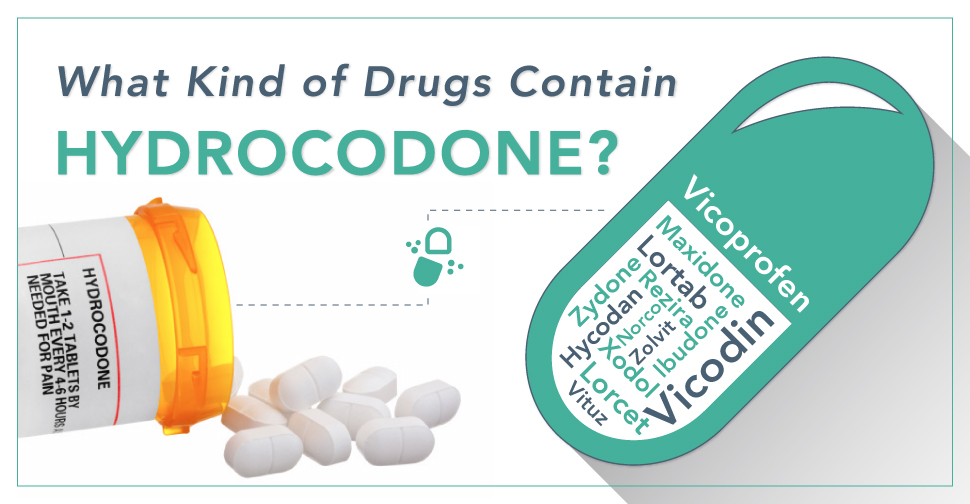
Opioid abuse is becoming an increasing problem in the country. The U.S. Drug Enforcement Agency (DEA) reports that hydrocodone “is the most frequently prescribed opioid in the United States.” An FDA blog elaborated on this, stating that in 2013, there was 137 million prescriptions. Hydrocodone is utilized in a wide variety of drugs. Understanding which can help you know if you are at risk for addiction.
What Is Hydrocodone And How Is It Prescribed?
The National Institute of Health (NIH) describes hydrocodone as a “a semisynthetic, moderately potent, orally available opioid that, in combination with acetaminophen, is widely used for treatment of acute or chronic pain, and in combination with antihistamines or anticholinergics used to treat cough.”
The preparations that are prescribed for pain management and for antitussive effects are typically used on an as-needed basis. Here are the current combinations, as listed by MedlinePlus, that are on the market today, grouped by the drugs that are combined within the medication:
- Containing Acetaminophen and Hydrocodone: Hycet, Liquicet, Lorcet, Lorcet Plus, Lortab, Maxidone, Norco, Vicodin, Vicodin ES, Vicodin HP, Xodol, Zolvit, and Zydone
- Containing Ibuprofen and Hydrocodone: Ibudone, Reprexain, and Vicoprofen
- Containing Homatropine and Hydrocodone: Hycodan, and Hydromet
- Containing Pseudoephedrin and Hydrocodone: Rezira
- Containing Chlorpheniramine and Hydrocodone: TussiCaps, Tussionex, and Vituz
Until recently, hydrocodone was only available in a combination with other drugs. In October of 2013 the FDA approved Zohydro ER, which became the first single-entity hydrocodone product available for the treatment of chronic pain.
The FDA described it as a medication for the “management of pain severe enough to require daily, around-the-clock, long-term treatment and for which alternative treatment options are inadequate.” This medication falls under Schedule II of the Controlled Substance Act and is an “extended-release/long-acting (ER/LA) opioid analgesic” which magnifies the risk of addiction, overdose, and death.
In late 2014, the DEA issued a final ruling that rescheduled hydrocodone combination products to Schedule II. Fortunately, within this same time period, the FDA recognized the risks associated with this drug, and in November of 2014 approved another single-entity extended-release preparation of the drug that was created with deterrents in place to help reduce the potential of abuse.
The FDA states that this product, Hysingla ER “is difficult to crush, break or dissolve. It also forms a viscous hydrogel (thick gel) and cannot be easily prepared for injection.” They did however note that while this new form would make abuse more difficult, it would not completely eliminate the possibility.
A narcotic, or opioid prescription pain medication acts on the brain’s opioid receptors to alleviate pain. Their chemical makeup is similar to heroin and can produce results that are in some ways comparable—the most notable being in terms of abuse—by inducing a state of euphoria by increasing the levels of dopamine within the brain.
Taken within the proper context, as prescribed by your supervising physician, these drugs have a significant purpose within the realm of medical treatment. When drugs within this class are abused or misused they hold the potential to cause serious side effects and grave danger.
The Dangers Of Misuse and Abuse, Leading to Addiction, Overdose, And Death
When this drug is taken in a way other than prescribed, including when it is taken more frequently, at a higher dosage, or by a method other than intended (crushing and snorting, smoking, or injecting) the risk of damage skyrockets. These things put a person at risk for addiction, and in the worst cases, overdose and death.
The Drug Abuse Warning Network (DAWN) reported that in 2011, 29% of the estimated 1,244,872 Emergency Department (ED) visits due to nonmedical use of pharmaceuticals were attributed to narcotic pain relievers. They also reported that from 2005-2011, this rate rose 117%, becoming stable and unchanging only between 2008-2011. Despite this stability, the nonmedical use of these prescription opioids, including hydrocodone, is at dangerous proportions.
As with any drug within the opiate class, use of hydrocodone carries significant risk for misuse and abuse. Two of the most commonly abused hydrocodone combination products are Norco and Vicodin. The DEA states that hydrocodone “is associated with more drug abuse and diversion than any other licit or illicit opioid.” Despite the fact that DAWN reported a 14% decrease in ED visits between 2010 and 2011, overall ED visits for hydrocodone have, according to DAWN, had an overall increase of 75% from an estimated 47,194 visits in 2005 to 82,480 visits in 2011.”
While some choose to swallow tablets whole, others crush them and smoke, snort, or inject the powder. Anytime a drug is snorted or injected it enters you system much faster than intended. This is because in its whole, unadulterated form, the drug is created in a manner that modulates its release over a specific and intended period of time. People can still abuse drugs in their whole form by taking larger doses in closer intervals.
Consuming the drugs in these ways can put a person at exceedingly high risk for seizure, respiratory arrest, hypoxia, acute liver injury (when used in combination with acetaminophen), overdose, coma, and even death. In the case of pure hydrocodone, this risk is far greater and immediate.
Remember, opiates depress the central nervous system and for this reason you need to be especially careful about taking other substances that might have that similar effect, like: alcohol, antihistamines, barbiturates, and benzodiazepines.
People with certain health conditions, including those with CNS or respiratory depression, COPD, hypothyroidism, a brain tumor, a past head injury, liver, kidney, lung, or Addison’s disease, need to be especially careful. For those that are using the combination forms, certain other health risks arise.
Acetaminophen, one of the drugs that are commonly combined with hydrocodone is especially hard on the liver. Individuals that have an existing liver condition or drink alcohol need to speak to a physician before using.
These drugs can cause physical dependence, even within the context of proper use. For this reason—even for individuals that use them in a prescribed manner—a person should seek medical supervision before they cease use. Quitting cold turkey can lead to uncomfortable and potentially dangerous symptoms. Tapering your doses gradually is the safest and most comfortable way to stop using this medication.
Although withdrawal can be done in a home setting with the aid of medication, it is not recommended as it is a mentally, physically, and emotionally strenuous process. We recommend detoxing in a facility this is specially trained to handle these situations, or in the most severe cases, a hospital.
Treatment For Hydrocodone Abuse And Addiction
Treatment for hydrocodone follows the protocols of treatment for opiate addiction. It is of great importance that you disclose your full health, medical, and addiction history before beginning treatment. This includes any medical conditions, medications or supplements you need, and current or past drug use.
Methodone and buprenorphine (Subutex) are two medications that are used to treat opiate addiction. Both simulate the effects of opiates on the brain. Due to this, withdrawal and craving symtpoms are greatly reduced.. In some cases, a person may also receive buprenorphine combined with Naloxone (Bunavail, Suboxone, Zubsolv).
Naltrexone, an antagonist, is used in a different manner. This drug prevents a person from achieving the high or euphoric feeling when they abuse the drug. This drug is especially useful in preventing relapse.
In addition to medical support, entering into rehabilitation (either in an inpatient or outpatient setting) may be immensely helpful in overcoming your addiction. Studies show that for many people, medically assisted treatment or therapy works better than therapy or medication alone.
It is also important to identify and treat any other co-occuring disorders, especially mental illnesses. Depression, anxiety, and other disorders can jeopardize your chances at obtaining a full recovery and also threaten your recovery with a heightened risk of relapse.
Let Us Help You Regain Control Of Your Life
 If you’ve found that your use has gone past the limits of what your doctor prescribed, or if you’re currently addicted, please don’t let it get out of hand. Take the time to contact us at DrugRehab.org. A few minutes of your time can help you to make the most out of the years to come.
If you’ve found that your use has gone past the limits of what your doctor prescribed, or if you’re currently addicted, please don’t let it get out of hand. Take the time to contact us at DrugRehab.org. A few minutes of your time can help you to make the most out of the years to come.
